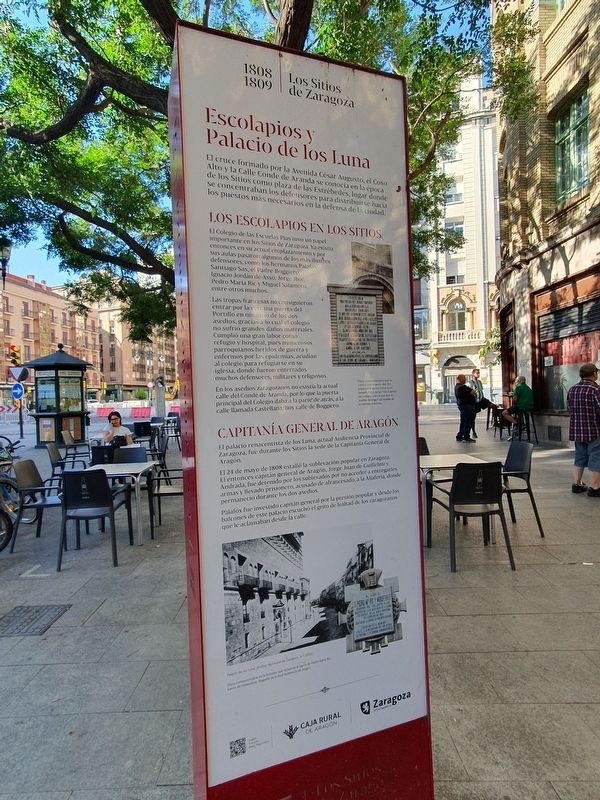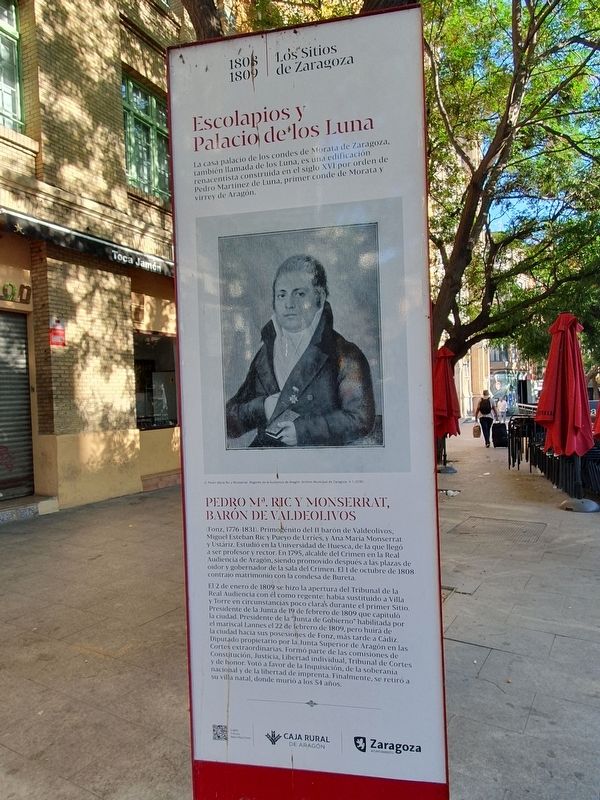Casco Antiguo in Zaragoza, Aragón, Spain — Southwestern Europe (Iberian Peninsula)
Escolapios y Palacio de los Luna
1808 · 1809 Los Sitios de Zaragoza
El cruce formado por la Avenida César Augusto, el Coso Alto y la Calle Conde de Aranda se conocía en la época de los Sitios como plaza de las Estrébedes, lugar donde se concentraban los defensores para distribuirse hacia los puestos más necesarios en la defensa de la ciudad.
Los Escolapios en los Sitios
El Colegio de las Escuelas Pias tuvo un papel importante en los Sitios de Zaragoza. Ya existía entonces en su actual emplazamiento y por sus aulas pasaron algunos de los más ilustres defensores, como los hermanos Palafox Santiago Sas, el Padre Boggiero, Ignacio Jordán de Asso, Jorge Ibor, Pedro María Ric y Miguel Salamero, entre otros muchos.
Las tropas francesas no consiguieron entrar por la cercana puerta del Portillo en ninguno de los dos asedios, gracias a lo cual el colegio no sufrió grandes daños materiales. Cumplió una gran labor como refugio y hospital, pues numerosos parroquianos heridos de guerra y enfermos por las epidemias, acudían al colegio para refugiarse en su iglesia, donde fueron enterrados muchos defensores, militares y religiosos.
En los asedios zaragozanos no existía la actual calle del Conde de Aranda, por lo que la puerta principal del Colegio daba á la parte de atrás, a la calle llamada Castellana, hoy calle de Boggiero.
Capitanía General de Aragón
El palacio renacentista de los Luna, actual Audiencia Provincial de Zaragoza, fue durante los Sitios la sede de la Capitanía General de Aragón.
El 24 de mayo de 1808 estalló la sublevación popular en Zaragoza. El entonces capitán general de Aragón, Jorge Juan de Guillelmi y Andrada, fue detenido por los sublevados por no acceder a entregarles armas y llevado prisionero, acusado de afrancesado, a la Maferia, donde permaneció durante los dos asedios.
Palafox fue investido capitán general por la presión popular y desde los balcones de este palacio escuchó el grito de lealtad de los zaragozanos que le aclamaban desde la calle.
Escolapios y Palacio de los Luna
La casa palacio de los condes de Morata de Zaragoza, también llamada de los Luna, es una edificación renacentista construida en el siglo XVI por orden de Pedro Martinez de Luna, primer conde de Morata y virrey de Aragón.
Pedro M. Ric y Monserrat, Barón de Valdeolivos
(Fonz, 1776-1831). Primogénito del II barón de Valdeolivos, Miguel Esteban Ric y Pueyo de Urríes, y Ana María Monserrat y Ustáriz. Estudió en la Universidad de Huesca, de la que llegó a ser profesor y rector. En 1795, alcalde del Crimen en la Real Audiencia de Aragón, siendo promovido después a las plazas de oidor y gobernador de la sala del Crimen. El 1 de octubre de 1808 contrajo matrimonio con la condesa de Bureta.
El 2 de enero de 1809 se hizo la apertura del Tribunal de la Real Audiencia con él como regente: habia sustituido a Villa y Torre en circunstancias poco claras durante el primer Sitio. Presidente de la Junta de 19 de febrero de 1809 que capitulo la ciudad. Presidente de la Junta de Gobierno" habilitada por el mariscal Lannes el 22 de febrero de 1809, pero huirá de la ciudad hacia sus posesiones de Fonz, más tarde a Cádiz. Diputado propietario por la Junta Superior de Aragón en las Cortes extraordinarias. Formó parte de las comisiones de Constitución, Justicia, Libertad individual, Tribunal de Cortes y de honor. Votó a favor de la Inquisición, de la soberania nacional y de la libertad de imprenta. Finalmente, se retiró a su villa natal, donde murió a los 54 años.
Pie de dibujos
Placa conmemorativa que se colocó con ocasión del 150 aniversario de los Sitios en el llamado Patio de las Tres Fuentes del colegio, y en el que aún es posible distinguir las huellas de la metralla francesa.
Palacio de los Luna. Archivo Municipal de Zaragoza, 4-1_0203.
Placa conmemorativa que se colocó con ocasión del 150 aniversario de los Sitios en el llamado Patio de las Tres Fuentes del colegio, y en el que aún es posible distinguir las huellas de la metralla francesa. Placa conmemorativa en la fachada que recuerda la figura de Pedro María Ric, barón de Valdeolivos, Regente de la Real Audiencia de Aragón.
D. Pedro María Ric y Monserrat, Regente de la Audiencia de Aragón. Archivo Municipal de Zaragoza, 4-1_02181
Piarists and the Luna family palace
The junction formed by the Streets: Avenida César Augusto, Calle Coso Alto and Calle Conde Aranda was known at the time of the Sieges as the Square called Plaza de las Estrébedes, the place where the defenders gathered to distribute themselves in the most necessary positions in the city’s defence.
The Order of the Poor Clerics Known as Piarists in the Sieges
The Piarist Schools played a major role in the Sieges of Zaragoza. This School already existed in its current site at that time and several of the most famous defenders attended its classrooms such as the Palafox brothers, Santiago Sas, Father Boggiero, Ignacio Jordán de Asso, Jorge Ibor, Pedro María Ric and Miguel Salamero, among many others.
The French troops did not manage to enter through the nearby Portillo Gate in any of the two sieges, thanks to which the school did not suffer major material damages. It fulfilled a great task as a shelter and hospital, since numerous parishioners wounded in the war and sick from the epidemics, came to the school to seek refuge in its church, where many military and religious defenders were buried.
In the sieges of Zaragoza, the current street of Calle del Conde de Aranda did not exist, hence the main gate of the School faced the rear section on a street called Castellana, which is Calle de Boggiero today.
Captaincy General of Aragon
The Renaissance palace of the Luna Family, today, the Provincial Court of Zaragoza, was the headquarters of the Captaincy General of Aragon during the Sieges.
On 24 May 1808, the popular uprising was sparked in Zaragoza. The Captain General of Aragon at that time, Jorge Juan de Guillelmi y Andrada, was apprehended by the rebels for not providing weapons to them and accused of being a French sympathizer, he was taken as a prisoner to the Aljafería Palace, where he remained during the two sieges.
Palafox was designated Captain General by popular pressure and from the Palace balconies, he heard the shouts of loyalty from the Zaragoza people who acclaimed him from the street.
Piarists and the Luna family palace
Palace Estate of the Counts of Morata in Zaragoza, also called the Palace of the Luna family, is a Renaissance building constructed in the 16th century commissioned by Pedro Martínez de Luna, the first Count of Morata and Viceroy of Aragon.
Pedro María Ric y Monserrat, Baron of Valdeolivos
(Fonz, 1776-1831). First-born son of the 2nd Baron of Valdeolivos, Miguel Esteban Ric y Pueyo de Urríes and Ana María Montserrat y Ustáriz. He studied at the University of Huesca, where he became a professor and dean. In 1795, he was the Mayor appointed criminal judge in the Royal Court of Aragon and was subsequently promoted to the posts of Hearing Judge (“oidor”) and Governor of the Criminal Court On 1 October 1808, he married the Countess of Bureta.
On 2 January 1809, he inaugurated the Court of the Royal Audience acting as Regent: he had replaced Villa y Torre in obscure circumstances during the first Siege. President of the Government Board on 19 February 1809 who surrendered the city. President of provisional “Government Board” authorised by Marshal Lannes on 22 February 1809, however he fled from the city to his country estates of Fonz. And subsequently to Cádiz. Landowner council member for the Higher Government Board of Aragon in the extraordinary Courts. He was a member of the Constitution, Justice, individual Freedom, Court of Justice and Honour commissions. He voted in favour of the Inquisition, national sovereignty and freedom of the press. Finally, he retired in his native town, where he passed away at the age of 54.
Captions
Commemorative plaque that was placed on the occasion of the 150th anniversary of the Sieges in the School courtyard called Patio de las Tres Fuentes and in which it is still possible to distinguish the marks of the French shrapnel.
Palacio de los Luna. Archivo Municipal de Zaragoza, 4-1_0203.
It commemorates Pedro María Ric, Baron of Valdeolivos, Regent of the Royal Court of Aragon.
D. Pedro María Ric y Monserrat, Regente de la Audiencia de Aragón. Archivo Municipal de Zaragoza, 4-1_02181
Erected by Ayuntamiento de Zaragoza. (Marker Number 5.)
Topics. This historical marker is listed in this topic list: Wars, Non-US. A significant historical date for this entry is January 2, 1809.
Location. 41° 39.262′ N, 0° 53.062′ W. Marker is in Zaragoza, Aragón. It is in Casco Antiguo. Marker is at the intersection of Avenida de César Augusto and Calle del Conde de Aranda, on the right when traveling south on Avenida de César Augusto. Touch for map. Marker is at or near this postal address: Av de César Augusto 52, Zaragoza, Aragón 50003, Spain. Touch for directions.
Other nearby markers. At least 8 other markers are within walking distance of this marker. Pedro Pablo Abarca de Bolea y Ximénez de Urrea (a few steps from this marker); Palacio de los Condes de Morata o de los Luna (within shouting distance of this marker); Pedro María Ric y Monserrat (about 90 meters away, measured in a direct line); Church of Santiago el Mayor (about 210 meters away); Calle Ramón Pignatelli, 43 (about 240 meters away); Plaza de Santiago Sas (approx. 0.3 kilometers away); Calle de Don Alfonso I (approx. 0.3 kilometers away); Calle Ramón Pignatelli, 70 (approx. 0.3 kilometers away). Touch for a list and map of all markers in Zaragoza.
Also see . . . Escolapios y Palacio de los Luna. The Ayuntamiento de Zaragoza maintains this website with Spanish, English and French versions of the markers in this series on the Sieges of Zaragoza in 1808 and 1809. (Submitted on October 10, 2023.)
Credits. This page was last revised on October 10, 2023. It was originally submitted on October 10, 2023, by J. Makali Bruton of Accra, Ghana. This page has been viewed 53 times since then and 11 times this year. Photos: 1, 2, 3. submitted on October 10, 2023, by J. Makali Bruton of Accra, Ghana.


